 June 14 -- Flag Day Special June 14 -- Flag Day Special

FLAGS
OF
OUR POW FATHERS
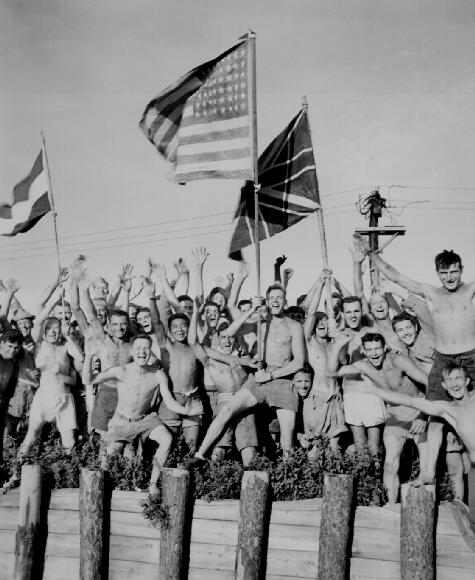
"Gaunt allied prisoners of war at Aomori [Omori] camp near Yokohama
cheer rescuers from U.S. Navy, waving flags of the United States,
Great Britain and Holland." Japan, August 29, 1945
The American flag is perhaps the most widely displayed flag in the world,
not only on flag poles, but on caps, backpacks, T-shirts, towels, coffee
mugs, shopping bags and scores of other items. To many it seems like just
another piece of merchandise.
But to thousands of men nearly 60 years ago, it was one of the most beautiful
sights they had ever seen. And they cried, unable to contain the joy in their
hearts -- their dream had come true.
I'd like to share with you on this
Flag
Day a few stories of the flags our POW fathers made at the end of
their captivity in prison camps in Japan. To them those flags were more than
just pieces of colored cloth and silk -- they were symbols of something very
dear to their hearts...
...symbols of home, their loved ones, their country they still served, and
the liberty and freedom they were now finally able to enjoy after 3½
years of being deprived of that which they so much yearned for.
It is no wonder then what strong emotions these simple pieces of cloth evoked!
And no wonder those surviving POWs to this day count it such a great blessing,
honor and privilege to have and enjoy the freedoms -- freedoms we take so
much for granted -- in a nation God has so uniquely blessed in His providence.
Clayton Dahl
Fukuoka #3, Kokura
August 1945. Japan. A liberated camp. Some of the boys got some materials,
red, white and blue, and they found a sewing machine and made a huge American
flag -- at least 20 feet by 15 feet.
My, how beautiful! They raised the flag on the flagpole and all the camp
came to see. Somebody got a bugle and they played taps for our dead buddies.
Oh, if only all Americans would know what it is like not to see our beautiful
flag for three and a half years.
Words
of War -- Fresno woman grasps late husband's story as a POW through his diary
of pain, triumph
Rodney
Kephart
Fukuoka #6, Mizumaki
On the morning of September 1, 1945, the day before the signing of the Japanese
surrender, senior American officers who were also prisoners in the camp came
to Kephart and fellow prisoner Ryland Barnett with the parachute silk from
the food drop. Knowing their liberation was near, the officers asked the
men to sew an American flag.
Since he was the only one who knew how to operate the camp's old Japanese
sewing machine, Kephart went straight to work. He and Barnett started the
flag at 10:00 a.m. and didn't quit sewing for more than 16 hours. In the
early hours of the next morning, with the flag completed, Kephart fell into
his bunk and slept. As dawn crept over the eastern sky, he was too worn out
to get up. But he heard the reveille bugle and cheering prisoners as his
flag was raised over the No. 6 prison camp in Orio, Fukuoka, Japan, at the
same time the Japanese signed the surrender.
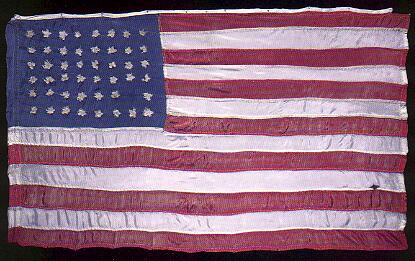
"I just rolled over in my bunk and started sobbing," he said. That moment
marked the end of 45 agonizing months as a prisoner of war, making Kephart
one of the longest-held prisoners of World War II. His flag flew proudly
over the prison camp for 11 days until he and the camp's other 1,700 American
and Allied prisoners were rescued.
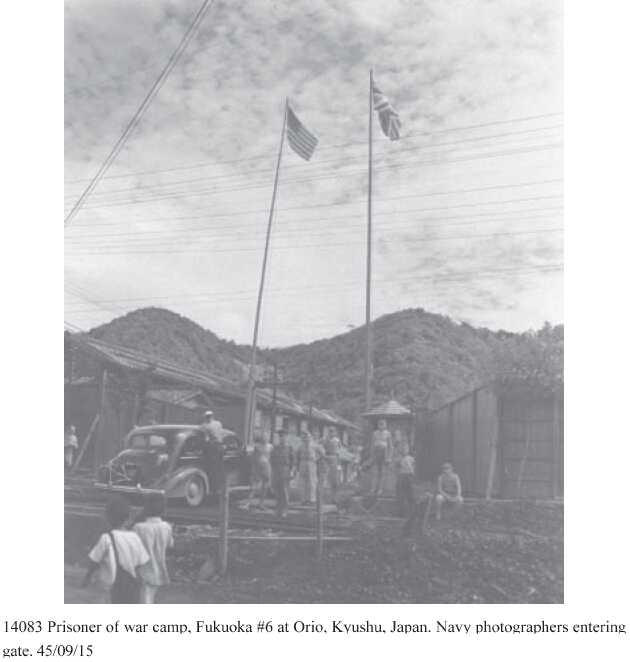
Capt. Jerome McDavitt
Hiroshima #6 (Omine)
About two or three minutes to twelve o'clock everybody was out to watch the
drop. Off to the east, in a beautiful blue sky containing two huge white
fleecy clouds, someone saw a speck. As it got bigger and we heard the buzz,
we saw there were two planes coming directly toward us between the clouds.
As they crossed overhead, they waved their wings. Their bomb bays, I noticed,
were still closed. They went on over and made a big left-hand turn and came
back between those two clouds again; this time the bomb bay doors were wide
open. From them they kicked out, each of them, twenty-foru double-deck fifty-five
gallon drums, welded and stacked. They floated down to us on sixteen red
parachutes, sixteen white parachutes, and sixteen blue parachutes. No reason
I can think of, except it was to show which the Air Force unit that made
the drop wanted to give us. I stood there amazed, and whatever words you
want to use would describe my feelings.
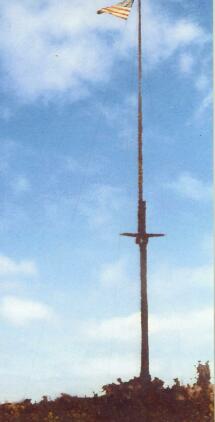 Several
of the men ran over to me. "Captain, sir." I didn't fuss at them, but I thought,
"You know, that's the first time you've referred to me as 'sir' in three
and a half years." I said, "Yes?" "Captain, sir, can we make one?" I didn't
want them to think I'd already figured it out, so I paused. Finally, I said,
"Yes, but be careful you don't tear the parachutes." Several
of the men ran over to me. "Captain, sir." I didn't fuss at them, but I thought,
"You know, that's the first time you've referred to me as 'sir' in three
and a half years." I said, "Yes?" "Captain, sir, can we make one?" I didn't
want them to think I'd already figured it out, so I paused. Finally, I said,
"Yes, but be careful you don't tear the parachutes."
The next morning an American flag was flying over our camp.
-- Death March -- The Survivors of Bataan
by Donald Knox
Note from Linda McDavitt, daughter:
"Enclosed is a picture of the flag made at Omine-machi upon liberation. There
is a story from a book and a picture of the men. The color photo was computer
enhanced from a black & white that we were told was a picture of the
flag flying after it was made. The black & white was at some reunion
and I assume that along with my grandmother, Dad, and Ben Guyton, the rest
of the men also were in Omine-machi and helped make the flag. The flag is
now housed at Texas A&M in College Station in the Alumni Center."
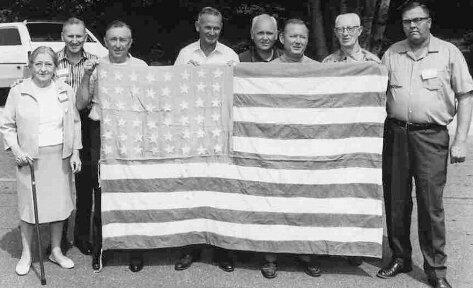
Baselio "Joe" Zorzanello
Sendai #6, Hanawa
After the surrender, the Japanese soldiers killed some American soldiers
"for no reason," according to Zorzanello. The worst thing he can recall was
the desecration of the American Flag.
Seeing the flag ripped apart and defiled made him feel naked, he said. "That
flag meant a lot to us, and to see them treat it like dirt really hurt."
The first night as prisoners, Zorzanello and the other men slept directly
on the hot sand. There were no blankets.
He said the flag desecration had a terrible effect on him.
"I had a nightmare that I was back in Massachusetts, where I was born," he
said. "I'll never forget it."
He described the nightmare as follows: "It was winter and there was a blizzard.
I was sleeping in the attic, with wind blowing the snow through. I was terrified,
and I went to my mother. I was broken hearted and demoralized. She tried
to comfort me.
"[When] I woke up, I didn't want my mother involved [in this war]. I was
a grown man, and I'd have to take care of myself. Physically, I was freezing
while lying on the hot sand.
"I guess my body had reacted to the dream. My skin was so cold. That's the
one thing through the entire war I couldn't cope with. [The nightmare] was
very traumatic," he said.
Veteran
recalls experiences in WWII
Otto Erler
Nagoya #1, Kamioka
"Otto was definitely a very blessed man. I think his would make a good story
for a lot of Americans," he said. "We can get through life without giving
up."
Otto Erler died quietly in his sleep in 1967 after 46 hard-lived years, but
Bud Erler and Bill Strouse have remained committed to his memory, visiting
those who served alongside Cpl. Erler and preserving the tale of the flag
for future generations.
Bud Erler faithfully wears a flag pendant as a reminder of his uncle.
"It says this is my family. This is where I come from," he said. "(The flag)
was a piece of America he held on to and he didn't give up."
For Mr. Strouse, a dream came true when he recently arranged to view Otto
Erler's flag at the Dallas Historical Society, where it was donated upon
the end of World War II.
"It was just fantastic. It was hard to believe it. I had heard so much about
it," he said. "The flag, as a symbol, means a heck of a lot to me, as it
does anyone in the military."
Former POW Mr. McDowell couldn't agree more.
"It meant a great deal to us - to our spirit. Spirit was what we lived on,"
he said. "It was one of a kind -- Otto and his flag."
Long,
great story about a WWII POW and his flag

"Prisoners of war possessed limited items of clothing, personal effects,
and field gear. Going through the packs and pouches, I noticed a thick lining
slightly sticking out at the bottom. I pulled it out, paying little attention
to the pack it was in. The item concealed a slit, purposely cut in the lining
of the pack."
Inside the pack was the POW flag that is now on display in our Americanism
Museum. Ill. Delsi surmised, "The flag must have been a source of courage
and strength to someone or to some group of Americans." While his assessment
is true, the flag continues to be a source of courage to generations of American
heroes.
Recently
rediscovered WW II POW flag
Col. Ralph T. Artman
Hiroshima #4, Mukaishima

Seven years ago a Fort Knox colonel stood in a Japanese prisoner of war camp
and watched misty-eyed as the rising sun emblem was struck from the flagstaff
and Old Glory went up in its place.
It was a crudely-sewn flag pieced together from parachute cloth, its stars
cut out jaggedly by sewing-kit tools and tin cans. But to the jubilant internees
who had labored to make it in the first few hours after word came of
Japan's surrender, craftsmanship was unimportant.....
He remembers how the men eagerly marked out their area with large letters
"POW" so that it could be seen from the sky. American planes began dropping
food and medical supplies ... red, white and blue parachutes floated down
on Mukaishima.
In those first frantic moments of freedom, the ex-prisoners realized they
had no American Flag. Col. Artman suggested making one from the parachutes.

"There was no means of sewing together the stars and stripes even after the
patterns were cut. Since the Americans were in command of the situation at
that time, I 'commandeered' the three local Japanese tailor shops to do the
sewing after Americans cut out the part according to rough specifications.
"We had the three tailor shops working constantly (and reluctantly) throughout
all of one night in order to have the flag ready as soon as possible. At
approximately 11 a.m. on the morning of Aug. 18, 1945, we lowered the Japanese
flag which had been flying over the camp and its place raised our American
flag.
"As the American flag was raised, we had a brief ceremony for the remaining
time we were there, our improvised American flag flew over the camp. I do
believe it is the first American flag raised on Japanese soil after the cessation
of hostilities."
"A lot of men lived and died dreaming of the day they'd see these colors
flying again."
First
To Fly Over Japan; Historic U.S. Flag Going to Museum
Some
men will never forget 'Bataan'
Carl S. Nordin
Nagoya #5, Yokkaichi
Life in prison camp was difficult, tedious and boring. After a couple of
years, the Japanese allowed a few musical instruments in camp. Naturally,
in a group of 2,000 men, there is considerable talent, so with these instruments,
a Corporal Biggs developed an entertainment troupe. Soon they were developing
USO-type programs. But there was barely room enough between the barracks
to accommodate an audience. Over a period of time, the Japanese had come
to realize this as a good way to keep the prisoners from becoming restive.
As the popularity of the troupe, and the confidence of the Japanese increased,
they were finally able to convince the Japanese to put on a full-fledged
program.
One condition was necessary, however. The Japanese would preview the program
before it was put on for the troops. This preview would be in the hospital
area. That way the sick could see it along with the Japanese, and with the
added benefit of shade for the viewers. The performance for the rest of the
camp would be out in the hot sun of the parade ground, where a stage had
already been erected for the use of the Japanese camp commander for his annual
(Pearl Harbor Day) reading of the Imperial Rescript. And for other occasional
diatribes. Programs were varied, but usually consisted of short skits, comedy
acts, a unique whistling act, and musical numbers of various kinds.
At the close of each program everyone would join in singing "God Bless America".
This went on for several months; the content was no different than before;
but at the performance out on the parade ground (where there were no Japanese
present), and at the close of the performance with everyone singing "God
Bless America", Corporal Biggs and Chief Bo'sun Regan stepped to the front
of the group as Chief Regan reached inside his denim jacket and began pulling
out the American Flag, and - handing one end to Corporal Biggs - they held
up the flag of the "41 Boat" for all to see, bullet holes and all!
Never have I heard "God Bless America" sung with more gusto and feeling as
those several hundred hard-bitten men stood out there in the hot sun, and
belted it out at the top of their lungs. For there before them was the flag
of our country, for which we had fought and sacrificed, and which we had
not seen in over two years. In all that group of men, I doubt there was one
dry eye as we viewed the symbol of the greatest country on earth.
Although this event occurred almost sixty years ago, and half a world away,
even to this day, when I see that flag or hear that song, I am overtaken
with a special feeling of awe and gratefulness.
A True Flag
Story
Pete George
Tokyo #12, Mitsushima
And the irony of that was that when they organized the new 4th division,
they took the flag and the standard which is a Marine Corp flag and kept
them covered and encased. They made a vow that they would not uncase those
colors until they came to Japan and liberated all of the 4th mariners and
throw a big parade for us, and that was what they did. They unfurled those
colors and I think that you could hear the uproar back in the States, you
know. And they went through that parade for us and everything. Well, you
cried really. Just no way that you could hold it back, you know.
http://www.chinamarines.com/docs/men_PG6.htm
Otto Erler
Nagoya #1, Kamioka
Not many of us have seen the colors struck. No, not retired. Not simply lowered
at the end of the day, but deliberately pulled down. World War II Marine,
Otto Erler, did from his foxhole on Corregidor.
Knocked unconscious by a Japanese mortar shell, Erler came too just as Japanese
troops swarmed over him. Corregidor had fallen. As Erler looked up past a
Japanese bayonet, up the barrel of the weapon, and over the shoulder of his
captor . . . he saw a tattered "Old Glory" coming down. In his head were
the words of a poem: "A moth-eaten rag on a worm-eaten pole. It doesn't look
likely to stir a man's soul . . ." But it did. Oh, how it did stir Erler's
soul. In that flag he saw America folding, America coming down. And that
20-year-old Marine from Dallas, Texas cried.
Later, under guard on a dock in Manila, enroute to a prisoner of war camp,
Erler snuck away into a small, empty office building on the pier, in search
of - of all things - toilet paper. In rummaging through the place, he found
none. But in a corner, in a dark closet, he found an American flag. It grabbed
him by the throat . . . it was a piece of home. It was something he could
have faith in. He didn't stop to think that prisoners were shot for less.
He snuck back into the ranks of prisoners and quickly hid the flag in his
duffel bag. Transported on prisoner ships, Erler kept the flag hidden, and
for the first time brought it out for a comrade's burial at sea. Done with
permission from his captors, Erler's flag draped the lead-filled, canvas
body bags of several who died on the trip.
When leaving the transport and heading to a more permanent camp, Erler was
able to smuggle the flag off the ship. He carried it with him and kept it
in his pillowcase. Eventually it was found and taken from Erler who, with
the ranking American officer, bravely told the Japanese as he handed it over,
"This is an American flag. We expect it to be treated with proper courtesy
and to be returned when we leave."
They reluctantly agreed, but not without penalties: rations would be halved
for thirty days, no cigarettes, and lights out at 9:00 p.m. In early 1944
Erler was transferred to a lead mine in Japan. As he prepared to depart,
he bravely asked for the return of the Flag. It was given over to him.
At the lead mine he was allowed to keep his flag, but only for burials. For
use in any other way, he would be held responsible. It found use ten times
in sixteen months. Then in August of 1945, after more than three years as
a POW, peace was at hand. The war was over and it was Erler's turn to strike
the colors. Down came the rising sun and up went the Stars and Stripes.
Through his years as a prisoner, Erler's flag buried 25 men and raised the
spirits and gave hope to thousands. That 42-star flag is still around. It
resides at the Dallas Historical society. It is tattered and torn. It's one
of those things best described by British General Sir Edward Bruce Hamley:
"A moth-eaten rag on a worm-eaten pole,
It doesn't look likely to stir a man's soul;
'Tis the deeds that were done 'neath the moth-eaten rag
When that pole was a staff and the rag was a Flag."
The
Story of Otto Erler, WWII POW
From The American Legion Magazine,1960
Abel F.
Ortega
Osaka #10, Maibara
You know my dad, Abel F. Ortega. He had 4 flags made from B-29 parachutes
at Camp Maibara, Japan. Since he was the camp artist, he was selected to
draw the flag designs and then have them made. He took the drawings and the
material to a Japanese tailor in Maibara and told him he had 3 days to make
the flags. It was the American, British, Austrailian, & Dutch flags.
Roger Mansell has a picture of the Camp and the
flags
flying at the main gate.
Abel Jr.
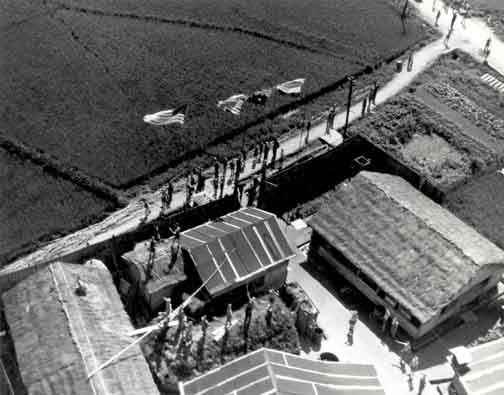
Martin
Christie
Tokyo #8,
Hitachi
"Page 67, Vol.1, Defenders of Philippines, Guam and Wake Islands
(Turner) shows the American group and the US Flag made from parachute
material. Two other flags were made, an Indonesian and a British. I have
heard that Captain Short, Hitachi Camp Commander, presented the US Flag from
Hitachi to the Truman Library and it was on display at one time."
Betsy Herold Heimke
Bilibid, Philippines
Though this page deals with the men who made flags, I found this about a
young girl named Betsy, not unlike that famous flag-maker back in 1776,
Betsy Ross:
We like to give credit to our speakers who are active in their communities
and in their schools. Betsy Herold Heimke, a member of the Heart of America
AXPOW Chapter in the Greater Kansas City area, is an active speaker with
an unusual story to tell.
Betsy's parents, Elmer and Ethel Herold were teaching school in the Philippines
when the Japanese bombed Pearl Harbor. Later that day, the Herolds heard
bombs exploding in their area of the Philippines. Twenty days later about
40 Japanese soldiers knocked on the Heralds' door in the middle of the night
and told them to attend a meeting in the morning to register. They went to
the meeting and never returned home. Betsy was 12 years old.
Betsy and her family ended up in the Bilibid Prison in Manila. The prison
conditions were unbelievably bad. Little food, no plumbing and the stench
was sickening. The U.S Army's 37th Division liberated the camp in February
1945. Of the 500 civilians at Bilibid, 456 survived. Betsy returned to the
US, finished her schooling, and earned a nursing degree from Northwestern
University in 1952. She later met and married Karl F. Heimke, a B-26 pilot
flying in the ETO.
When Betsy tells her "Prison Camp Stories" she is amazed that many Americans
did not know that the Japanese incarcerated civilians during WWII. Her listeners
are in awe when she tells her experiences (as a teenager) under such deprived
conditions.
While incarcerated at Bilibid, Betsy made a small American flag. The flag
is now framed and protected by a glass cover. She takes the flag with her
when she speaks to schools and civic clubs. At a recent talk to the Daughters
of the American Revolution's 106th annual conference, Betsy writes, "When
I showed them my framed little American flag their tearful and standing ovation
made me cry. I was really overwhelmed."
http://www.axpow.org/education.htm
Harvey Boatman
Burma
Three days before the Japanese surrendered, Boatman's appendix ruptured.
A Dutch doctor, on his deathbed, instructed Boatman's comrades on how to
use a bayonet to remove the appendix. Six men held Boatman down for the amateur
surgery. The doctor died the next day.
Once the Japanese surrendered, Boatman sewed a U.S. flag using a small,
pedal-operated sewing machine that someone had found near the prison camp.
He cut cloth with the same bayonet that had been used to remove his appendix.
That flag flew over the prison compound and now sits in glass at an Army
Reserve center museum in Witchita Falls.
Survivor's
friends, strength got him through illnesses
Conrad G.
Russell
Osaka #6, Akenobe
"There was a flag made at Akenobe 6-B. I have a photo of it. My uncle,
Conrad G. Russell, USMC, was there." -- Jeff Russell
The sudden actual ending of the war was so surprising that we may have been
caught "off guard". The next morning things began to happen. A 'limey' p.o.w.
whom we called Harry, stepped into our building. He had an old battered pillow
which he'd managed to hang onto from his time, four years ago, in Hong Kong.
He told us that many times during the Jap's surprise shakedowns, that old
pillow had been pummeled as guards searched for any hard object(s). This
day, Harry ripped open a seam and pulled out a beautiful Union Jack, about
six feet long. A cheer went up from everyone in the building! He had managed
to secret the flag and carry it with him since the fall of Hong Kong. (Our
camp was composed of about half British and Aussies and half Americans.)
What a dilemma! We must have an American flag, so the only thing to do was
to make one. Scrounging around we came up with enough material for the stars
and stripes but no blue for the flag's field. One of the guys told of a 'limey'
in the so-called medical ward who wanted to contribute a blue shirt that
he had secreted away. He mst have had grand plans for the use of that shirt,
but decided it could be better used here. We thanked him profusely but had
nothing to give him in return, which we wanted to do. What we did do was
assure him, and the other sick, was that upon making contact with rescuers,
we would give them a map that would send them directly here for their rescue.
(At the end, it did work out, just that way.) A couple of guys worked on
it's crude construction but when they were finished, we were proud of it.
We planned to have a flag-raising service the next morning. The morning dawned
beautiful and the sunrise was just perfect! The American flag and the Union
Jack, from Hong Kong, were raised simultaneously. It's a memory which I and
the other survivors, who were there, will cherish for as long as we live!
The Limey's and Aussie's sang "God Save the King", then the Americans sang
"The Star Spangled Banner". We were located at a high altitude, anyway, but
as the flags were raised, I felt at a higher level still -- as though I could
look down on all the Japanese cities, even the Imperial Palace.
My husband and I attended the Western States Chapter of the ADBC convention
in Ventura a few months ago. We brought Mr. Jay Rye, a veteran along with
us to the convention. Mr. Rye was on the same hellship (the Noto Maru), and
the same last two POW camps as my dad (Sgt. George P. Nord) in Japan. These
two camps were Omori and Sendai 10D.
During the trip, Mr. Rye shared several stories with us. He was a pleasure
to be with. One of his stories had to do with the men making a flag at Sendai
10D. He said he wasn't sure where they found the sheets and paint, but both
an American flag and a British flag were made. There was some discussion
between the American and British officers as to whose flag would wave to
the right. Mr. Rye said he thought to himself, here the war is ended and
we're going to have WWIII over the flag waving. This was an indication of
just how proud the men were of their respective countries.
In the end, the American officer won because there were twice as many Americans
in the camp as British.
If you can confirm this story, that would be great.
Respectfully,
Greta A. Janz
Daughter of George P. Nord
20th Air Base, 27th Material Squadron
Survivor of Bataan, hellships and several POW camps
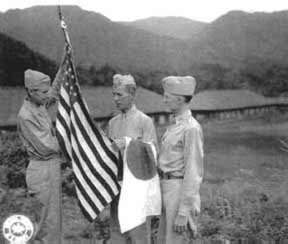
It would be easier to name a camp where NO flag was made. At
Rokuroshi,
one of the men had hidden a full size American flag for the entire war and
pulled it out the minute he learned the war was over. It was flying within
minutes.
The Yanks made flags at
Hirohata
and at
Maibara.
Take a look at the Hirohata pages. The one from Rokuroshi is in the lobby
of the capitol building for New York in Albany.
Roger Mansell
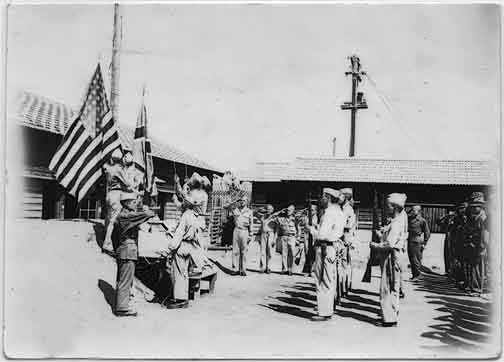
Tokyo #9, Ashio
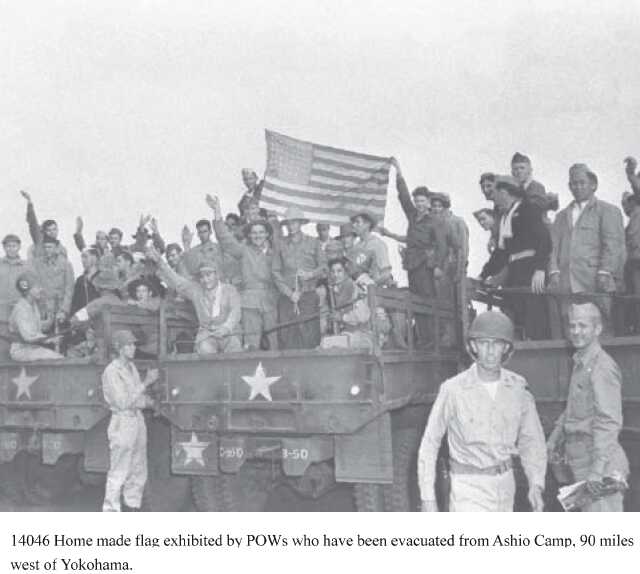
Fukuoka #9, Miyata
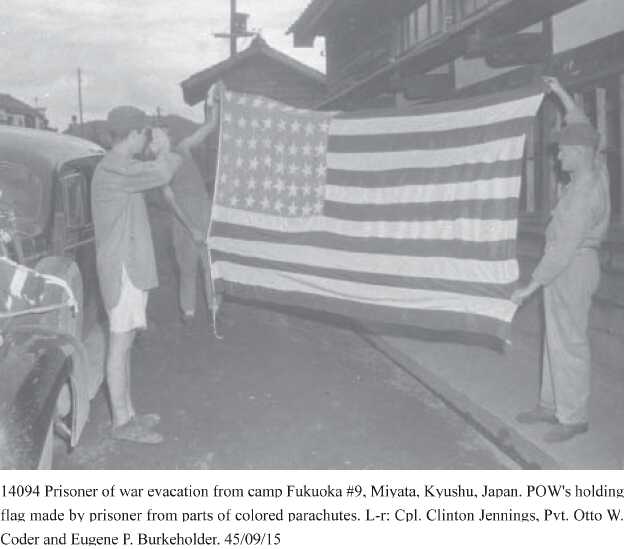
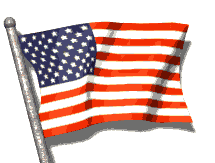
"Oh, if only all Americans would know what it is like not to see our beautiful
flag for three and a half years."
Back to Update Page
|